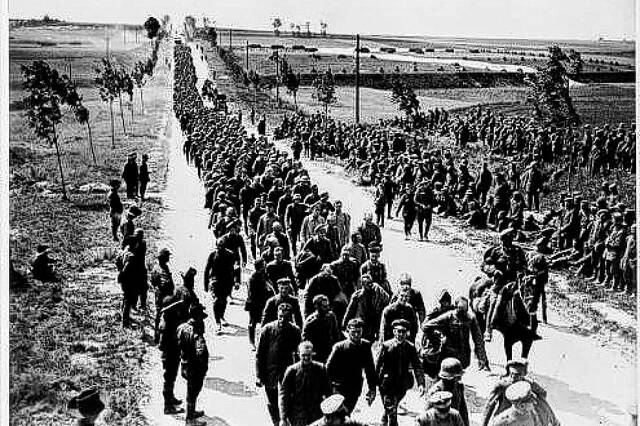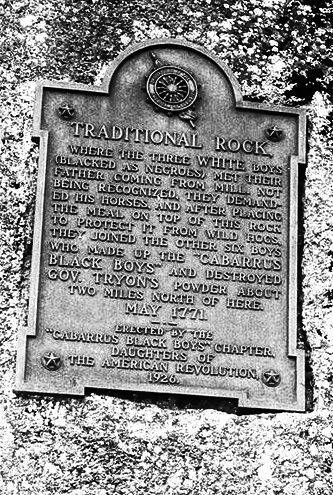
A total of 33 German sailors were plucked from the water and taken to Fort Bragg and confined as prisoners of war in May 1942.
THIS WEEK IN HISTORY
ROBESON COUNTY HISTORY
May 10, A total of 2,500 heard Stephens preach strong sermon at tabernacle last night. On May 10, 1924 (100 years ago) the Robesonian’s front page included the following: Results of the series of meetings conducted by Evangelist Geo. T. Stephens and his party have been evident since the first meeting, but last night’s attendance of 2,500 and the more than 200 who signified that they wanted the prayers of Christian people more than proved that the meeting is going to be the greatest spiritual awakening that his section of the country has ever had. Members of the executive committee of the meeting made short talks before the sermon expressing their confidence in Mr. Stephen and his party and heartily endorsed them and the meeting. H. M. McAllister, Chairman, called on L.R Varser, H.E.. Stacy, Ed B. Freeman, K.M. Barnes and L.H. Caldwell.
“It’s a great effort for the people of Lumberton, pregnant with great good,” said Mr. Varser. “The time is ripe for Lumberton community to have such as great revival,” said Mr. Varsey.
May 5. St. Pauls Church plans for 175th anniversary. On May 5, 1974 (50 years ago) The Robesonian carried the following story: St. Pauls Presbyterian Church will celebrate two momentous events in its life on May 12: the 175th birthday and the 135th “May Communion,” which also is called “Homecoming.”The speaker for the observance at 11 a.m. will be Rev. Alexander (Sandy) McClureMcGeachy, whose ancestors figure prominently in the history of the church.
May 1. Justices delay ruling on ethics challenge. On May 1, 2015, The Robesonian reported the following: PEMBROKE — Justices on the Lumbee Supreme Court were at a loss Thursday to rule on the constitutionality of the tribe’s current ethics ordinance when no one could supply them with a copy of the original 2005 ordinance. That ordinance, needed by the justices to compare with the law on the books since 2010, had been found by the court years ago to be unconstitutional and ordered re-written to meet the Lumbee Constitution’s requirement that there be an ethics ordinance in place to regulate government activity.
May 8. Local legislators have ideas for $400M surplus. The May 8 2015, Robesonian reported the following: Although happy that North Carolina is expecting a $400 million surplus this fiscal year, local legislators say it was built on the backs of the middle class. But the lawmakers, all Democrats, have ideas on how the money should be spent.
“This $400 million surplus confirms what I have been concerned about from the start,” said Rep. Charles Graham, a Democrat from Lumberton. “We are giving tax credits to North Carolina’s wealthiest citizens at the expense of working families and those on fixed income.”
May 6. City sees business rebound. On May 6, 2023, The Robesonian reported the following: The City of Lumberton seems to be in the midst of a business rebound, exiting its pandemic slump.
“It’s just a different environment,” Lumberton Mayor Bruce Davis said. “The opportunities are greater, the monies are greater and it makes for super progress. What’s it going to be 20 years from now?”
The city’s Inspection and Planning Departments have issued plan approval on several projects including a WaWa’s which is expected to be at the site of the recently demolished Super 8 motel on Fayetteville Road, a 711 Convenience Store/Scrubby’s Car Wash at the old movie theater site on Roberts Avenue, and a Royal Farms Gas Station at the demolished site of Village Station restaurant, also on Roberts Avenue.
NORTH CAROLINA HISTORY
May 4, Wing Walker and Daredevil Bonnie Rowe. On May 4, 1932, Bonnie Rowe, legendary wing walker, was killed performing a stunt in Lawrenceville, Georgia. He was 37-years-old. He had almost been killed two years before in Lenoir when, upon opening, his parachute split in two places.
Rowe, who had his roots in North Carolina and had lived in Charlotte, had had moved about a year prior to his death. Married to Alexander County native Florence Pool, Rowe met Pool when he was hurt performing a stunt in Gastonia. She nursed him while he recovered. The two were married soon after, much to the surprise of the Taylorsville community.
A World War I Navy veteran, Rowe starred in Mabel Cody’s Flying Circus and performed more than 12,000 jumps. He was known for performing other stunt, too, including running along the top of a speeding train to grab a ladder hanging from beneath an airplane.
The Charlotte Observer reported that at his death Rowe was hanging from the undercarriage of a plane, lost his grip and plunged to the ground. Although Rowe’s widow and son remained close to their family in North Carolina, they lived in Georgia for the rest of their lives.
May 4. Randy Travis and His Route to Country Music Stardom. On May 4, 1959, country music star Randy Travis was born in Union County. Raised on a Marshville turkey farm, Travis began playing guitar at age 10, discovering what would become a lifetime love of country music.
As an adolescent, Travis had several run-ins with the law, and he dropped out of high school at 15. To help put him back on track, Lib Hatcher, owner of a Charlotte club where Travis performed, adopted him. With her help, Travis focused seriously on his music career and moved to Nashville.
Warner Brothers Records signed Travis in 1985. His first hits included “1982” and “On the Other Hand.” Travis’s second album, Always and Forever, released in 1987, proved his staying power in the country music spotlight.
The authenticity and traditional approach Travis gives to his music distinguishes him as a country music legend. His style is said to be strongly influenced by the legendary Hank Williams. Fellow musicians, including Garth Brooks and Clint Black, now claim they looked to Travis for inspiration.
Travis has won many accolades in his long career including six Grammys, seven Academy of Country Music Awards and nine American Music Awards.
May 5: Reverend Gary Davis, Durham Blues Legend. On May 5, 1972, legendary bluesman Reverend Gary Davis died. Renowned as a finger-style ragtime guitar player, he influenced generations of players.
Davis got his start as a popular street musician in Durham in the 1930s, where he was known as “Blind Gary Davis.” Ordained as a minister of the Free Baptist Connection Church in Washington, North Carolina in 1913, he began to tour as a singing gospel preacher.
Davis recorded with Blind Boy Fuller in New York in 1935. His “Piedmont style” of the blues was akin to the music performed later by Brownie McGhee and Sonny Terry who popular around the same time. As his popularity grew, Davis toured the folk and blues revival circuits, playing jumbo Gibson acoustic guitars. His students included David Bromberg, the Grateful Dead’s Bob Weir and the Jefferson Airplane’s Jorma Kaukonen. His finger-picking guitar style influenced many other musicians, including Jerry Garcia, Ry Cooder, Dave Van Ronk, Taj Mahal and Bob Dylan.
In addition to being a performer and teacher, Davis was a prolific composer of both religious and secular music. He incorporated John Phillips Sousa marches, spirituals and square dance music into intricate guitar instrumentals. Songs associated with Davis include “Baby, Can I Follow You Down,” “Candy Man,” “Cocaine Blues” and “Samson and Delilah.”
May 5: The CSS Albemarle and the Battle of Batchelor’s Bay. On May 5, 1864, the CSS Albemarle crossed Batchelor’s Bay and fought seven Union warships. Upon entering the Albemarle Sound the Confederate ram, under command of Captain J. W. Cooke, and her escort vessels were attacked by four double-ended steamers and three smaller gunboats under Captain Melancton Smith. The Albemarle opened attack late in the day. Leading the first line of attack was the Union flagship, the Mattabesett. The Albemarle returned fire, destroying the launch and cutting away some of the standing and running rigging.
The steamer Sassacus then struck the ironclad. The crew of the Albemarle responded with a 100-pound shot through the starboard boiler of the Union vessel and into her wardroom. The scalded men managed to free the ship as they drifted out of range. All parties then withdrew. Only by throwing butter, lard and bacon into the boilers was it possible for the crew of the Albemarle to raise enough steam to return to Plymouth.
May 6 Maiden Voyage of Otway Burns’s Prometheus, 1818. On May 6, 1818, 11 years after Robert Fulton’s invention of the steamship, Otway Burns launched a similar vessel in North Carolina.
Burns, known for his privateering during the War of 1812, built the Prometheus at his waterfront lot, number six, at the mouth of the White Oak River in Swansboro. He attracted the attention of North Carolina newspapers as he strove to launch the Prometheus before the Henrietta, built that year in Fayetteville.
The steamship Prometheus entered service on the Cape Fear River by the summer of 1818, shortly before the Henrietta. The vessel operated a route between what’s now Southport and Wilmington, which took about four hours and cost passengers $1 each way.
Perhaps two of the most famous of the passengers on the Prometheus were President James Monroe and Secretary of War John C. Calhoun, who rode the steamship to inspect Fort Johnston in April 1819.
May 7: “War on Poverty” Photo Op in Rocky Mount, 1964. On May 7, 1964, President Lyndon Johnson, accompanied by Governor Terry Sanford, visited the home of tenant farmer William David Marlow near Rocky Mount to promote the President’s “War on Poverty” initiative.
The 15-minute visit was essentially a photo opportunity to launch Johnson’s tour of Appalachia. There have been questions over the years as to why Rocky Mount was selected, not being particularly close to the mountains, though many have assumed it has something to do with the town’s name.
Though the Nash County family that hosted Johnson didn’t live in Appalachia, it certainly met the rest of the criteria for people to be helped by the president’s programs. Marlow lived with his seven children, his wife and his mother-in-law. A World War II veteran, he suffered from a chronic back injury and earned less than $1,500 per year.
To emphasize the family’s living conditions for the visiting journalists and politicians, the Marlows were instructed to hang a load of laundry on their clothesline and to keep their children barefooted. After the visit, the family struggled with the stigma of poverty. Having never thought of herself as poor, Mrs. Marlow later wrote the president, “We have just found out that we are the joke of a whole nation.”
May 8: William Lenoir, Frontier Patriot. William Lenoir, Frontier Patriot. On May 8, 1751, Revolutionary War-era leader William Lenoir was born in Virginia. Lenior first worked as a teacher and founded several schools before he became a surveyor, and moved westward to take advantage of opportunities along the frontier.
Just after his move, the Revolutionary War broke out. Lenoir answered the call to duty, serving in the militia, most notably at the Battle of Kings Mountain, with that service extending until he resigned during the War of 1812.
In addition to his military service and success as a planter, Lenoir was very active in government. He was appointed justice of peace and served in both houses of the state legislature for nearly two decades. As a delegate to the state ratifying conventions of 1788 and 1789, Lenoir voted against the U.S. Constitution because it did not include a bill of rights.
Lenoir went on to unsuccessfully run for governor and both houses of Congress before his death in 1839. Lenoir County, the town of Lenoir and Lenoir Hall at UNC, where he was one of the first trustees, are all named in his honor.
His home, Fort Defiance, is now a popular privately-run historic site in Caldwell County.
MAY 9: Gunpowder Raid by Black Boys of Cabarrus. On May 9, 1771, nine young men from what would become Cabarrus County raided a British convoy carrying gunpowder to General Hugh Waddell’s militia. The attack happened on Phifer’s Hill just north of Concord.
The men disguised themselves as American Indians before they blew up two wagons worth of gunpowder. They already had darkened their skin as part of their disguises, and the explosion of the powder coated them with additional soot, blackening their faces and earning them the moniker of the “Black Boys of Cabarrus.”
MAY 9. U-Boat Survivors Added to POW Camp Rosters. On May 9, 1942, the U.S. Coast Guard sank German U-boat 352 off the Outer Banks.
Thirteen German sailors died and 33 were plucked from the water. They were taken to Fort Bragg and confined as prisoners of war. During the course of the war thousands of POWs—mostly Germans and Italians—were captured and sent to camps in North Carolina.
Most POWs were brought to North Carolina from abroad. Fritz Teichmann was a member of the German Luftwaffe (the air corps) and was captured in Sicily in July 1943. He was held as a POW at Camp Butner in Granville County. Giuseppe Pagliarulo, a soldier in Benito Mussolini’s Italian army, was captured in Tunisia in North Africa in May 1943 and held at Camp Sutton in Monroe.
So many POWs were brought to the state that men were sent from larger military bases to smaller branch camps. These smaller camps housed up to 500 men each and were located in 16 communities around the Tar Heel state, including Whiteville, Roanoke Rapids, Williamston and Hendersonville.
From there, they were placed on compulsory work details and sent out to cut pulpwood, dig ditches, wash dishes and pick apples. Their employers—farmers, loggers and restaurant owners—knew of the camps but otherwise their presence was relatively secret.
May 10. Military Order Beginning the Trail of Tears. On May 10, 1838, General Winfield Scott issued a proclamation to eastern Cherokees, by order of President Martin Van Buren, to evacuate their ancestral homeland. The subsequent military-enforced migration to what is now Oklahoma became known as the Trail of Tears.
The events leading to the migration were set in motion eight years earlier, in 1830, with the passage of the Indian Removal Act by the U.S. Congress. The act gave the president authority to exchange unsettled land west of the Mississippi River for Indian land in existing states.
In 1835, an unauthorized group of Cherokee leaders entered into the Treaty of New Echota in Georgia with the Federal government, giving all Cherokee territory in the South to the Federal government in exchange for land in the west. Chief John Ross, with more than 15,000 Cherokee signatures, petitioned the Senate not to ratify the treaty. The effort was to no avail; the treaty was ratified in 1836.
Two years later, in 1838, with the Cherokee still occupying their lands, General Scott came to issue the ultimatum to evacuate, backed by more than 5,000 troops. His May 10 proclamation read in part:
Cherokees! The President of the United States has sent me, with a powerful army, to cause you, in obedience to the Treaty of 1835, to join that part of your people who are already established in prosperity, on the other side of the Mississippi… . The full moon of May is already on the wane, and before another shall have passed away, every Cherokee man, woman and child … must be in motion to join their brethren in the far West.
Cherokee people were initially placed in internment camps in western North Carolina where many died prior to the tragic exodus.
NATION AND WORLD HISTORY
May 4, four killed at Kent State. On May 4, 1970, Ohio National Guardsmen opened fire during an anti-war protest at Kent State University, killing four students and wounding nine others.
May 5, Shepard is first American in space. On May 5, 1961, astronaut Alan B. Shepard Jr. became America’s first space traveler as he made a 15-minute suborbital flight aboard Mercury capsule Freedom 7.
May 6, the Hindenburg crashes. On May 6, 1937, the hydrogen-filled German airship Hindenburg caught fire and crashed while attempting to dock at Lakehurst, New Jersey; 35 of the 97 people on board were killed along with a crewman on the ground.
May 7, Germany’s surrender. On May 7, 1945, Germany signed an unconditional surrender at Allied headquarters in Rheims (rams), France, ending its role in World War II. In 1975, President Gerald R. Ford formally declared an end to the “Vietnam era.” In 2019, two students opened fire inside a charter school in a Denver suburb not far from Columbine High School, killing a fellow student, 18-year-old Kendrick Castillo, who authorities said had charged at the shooters to protect classmates. (Both attackers would be sentenced to life in prison; one who was 16 at the time of the shooting could be eligible for parole after about 20 years.)
May 8, Stepping away from apartheid. On May 8, 1996, South Africa took another step from apartheid to democracy by adopting a constitution that guaranteed equal rights for Blacks and whites.
May 9, Mandela chosen to lead South Africa. On May 9, 1994, South Africa’s newly elected parliament chose Nelson Mandela to be the country’s first Black president.
May 10, transcontinental railroad finished. In 1869, a golden spike was driven in Promontory, Utah, marking the completion of the first transcontinental railroad in the United States.
Executive Editor David Kennard compiles the History column from Robesonian archives, the North Carolina Department of Natural and Cultural Resources and Associated Press reports.








